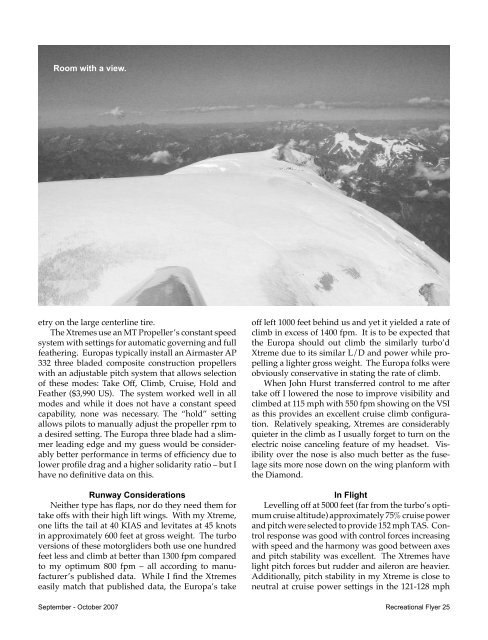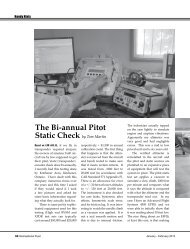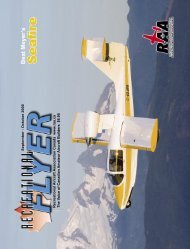September - October - The Recreational Aircraft Association
September - October - The Recreational Aircraft Association
September - October - The Recreational Aircraft Association
Create successful ePaper yourself
Turn your PDF publications into a flip-book with our unique Google optimized e-Paper software.
Room with a view.<br />
etry on the large centerline tire.<br />
<strong>The</strong> Xtremes use an MT Propeller’s constant speed<br />
system with settings for automatic governing and full<br />
feathering. Europas typically install an Airmaster AP<br />
332 three bladed composite construction propellers<br />
with an adjustable pitch system that allows selection<br />
of these modes: Take Off, Climb, Cruise, Hold and<br />
Feather ($3,990 US). <strong>The</strong> system worked well in all<br />
modes and while it does not have a constant speed<br />
capability, none was necessary. <strong>The</strong> “hold” setting<br />
allows pilots to manually adjust the propeller rpm to<br />
a desired setting. <strong>The</strong> Europa three blade had a slimmer<br />
leading edge and my guess would be considerably<br />
better performance in terms of efficiency due to<br />
lower profile drag and a higher solidarity ratio – but I<br />
have no definitive data on this.<br />
Runway Considerations<br />
Neither type has flaps, nor do they need them for<br />
take offs with their high lift wings. With my Xtreme,<br />
one lifts the tail at 40 KIAS and levitates at 45 knots<br />
in approximately 600 feet at gross weight. <strong>The</strong> turbo<br />
versions of these motorgliders both use one hundred<br />
feet less and climb at better than 1300 fpm compared<br />
to my optimum 800 fpm – all according to manufacturer’s<br />
published data. While I find the Xtremes<br />
easily match that published data, the Europa’s take<br />
off left 1000 feet behind us and yet it yielded a rate of<br />
climb in excess of 1400 fpm. It is to be expected that<br />
the Europa should out climb the similarly turbo’d<br />
Xtreme due to its similar L/D and power while propelling<br />
a lighter gross weight. <strong>The</strong> Europa folks were<br />
obviously conservative in stating the rate of climb.<br />
When John Hurst transferred control to me after<br />
take off I lowered the nose to improve visibility and<br />
climbed at 115 mph with 550 fpm showing on the VSI<br />
as this provides an excellent cruise climb configuration.<br />
Relatively speaking, Xtremes are considerably<br />
quieter in the climb as I usually forget to turn on the<br />
electric noise canceling feature of my headset. Visibility<br />
over the nose is also much better as the fuselage<br />
sits more nose down on the wing planform with<br />
the Diamond.<br />
In Flight<br />
Levelling off at 5000 feet (far from the turbo’s optimum<br />
cruise altitude) approximately 75% cruise power<br />
and pitch were selected to provide 152 mph TAS. Control<br />
response was good with control forces increasing<br />
with speed and the harmony was good between axes<br />
and pitch stability was excellent. <strong>The</strong> Xtremes have<br />
light pitch forces but rudder and aileron are heavier.<br />
Additionally, pitch stability in my Xtreme is close to<br />
neutral at cruise power settings in the 121-128 mph<br />
<strong>September</strong> - <strong>October</strong> 2007 <strong>Recreational</strong> Flyer 25




